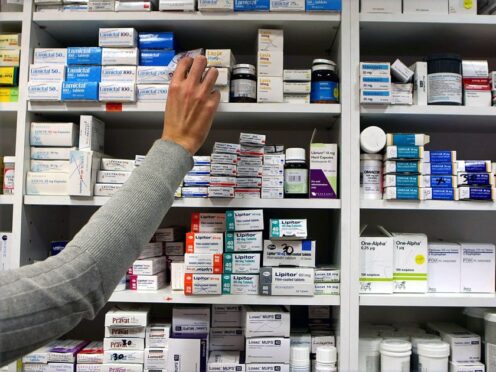
A health minister has been challenged over concerns that pharmacy technicians are doing more than they are qualified to amid a surge in demand for services in the sector.
Dame Andrea Leadsom appeared in front of the Health and Social Care Committee on Tuesday alongside NHS bosses for the concluding evidence session in its pharmacy inquiry.
Labour’s Paulette Hamilton claimed there have been “concerns over the extent to which pharmacy technicians are being pushed into the front line” of clinical practice, and are being asked to do “more and more” as pharmacies have not got the level of staff to keep up with demand.
It follows the launch in January of Pharmacy First, an initiative which urges the public to visit their local pharmacy to be treated for seven common conditions rather than their family doctor.
According to the Company Chemists’ Association, its members carried out almost 50,000 Pharmacy First consultations in the first month.
However, Ms Hamilton claims technicians – who undergo a two-year course and work under the supervision of a pharmacist – are being presented under “the generic term of pharmacy professionals”, which she said “is blurring the lines”.
The MP for Birmingham Erdington likened the situation to that of physician associates (PAs), staff employed in GP practices to support doctors in the diagnosis and management of patients.
PAs have been under increased scrutiny following the death of Emily Chesterton in November 2022.
The 30-year-old had been under the impression that she was seeing a GP, but was actually seen twice by a PA who failed on both occasions to spot that her leg pain and breathlessness was a blood clot, which ultimately travelled to her lungs.
Ms Hamilton said: “I’m just concerned with what we’re trying to do with pharmacy, at the pace we’re going, what we’re asking of technicians – it’s just too much at this point.
“They’re coming out maybe doing more than they’re qualified to do. How are we going to stop the same thing happening in pharmacy that happened with doctors?”
In the somewhat tense exchange, Dame Andrea condemned the line of questioning as “extremely unhelpful”, denied a “blurring of the edges” and said “patient safety is absolutely paramount”.
“There isn’t an intention or even a carelessness that would enable pharmacy technicians to start practising above their training,” the health minister added.
“The idea is to improve patient access and patient convenience, whilst retaining patient safety and, therefore, to make the maximum use of the training levels of different professional people.
“And I actually would say… it’s extremely unhelpful when parliamentarians somehow suggest that this is some kind of Wild West or free-for-all because that simply couldn’t be further from the truth.”
Ms Hamilton argued that the concern “is coming from pharmacists”, adding: “We have recently had an issue with our doctors with the associates and at the moment we are pushing down the road.
“Are we listening to what our pharmacists are saying? It’s not the Wild West. I’ve known you for years. Don’t do the jibes. At the end of the day, there is an issue out there.”
The General Medical Council launched a consultation on Tuesday into how it should oversee NHS PAs.
It is seeking views from representatives of patients, PAs and anaesthesia associates (AAs), doctors and employers, and will examine the rules, standards and guidance over how regulation will be delivered.
Defending the collective use of the term “professionals” in the pharmacy sector, David Webb, chief pharmaceutical officer for NHS England, said both pharmacists and technicians are regulated by the General Pharmaceutical Council.
“That, I think, is a very important backstop and explanation of the patient safety context in which we operate, because these are not unregulated workforces,” he said.
“These both have to be registered with the General Pharmaceutical Council to practise and are subject to the fitness to practise standards that the regulator imposes.”
He also said the Department of Health and Social Care is currently considering responses to a consultation on pharmacy supervision.
Labour MP Rachael Maskell asked if the potential “blurring” of professional boundaries as the pharmacy workforce expands is being addressed through “a prism of patient safety” and regulation.
Dame Andrea said there is forthcoming secondary legislation “to expand – but very, very carefully – the role of pharmacies’ staff to be able to take on more but in a very, very controlled way”.
She added that “patient safety comes absolutely first – there will not be skill drift”.
“What this is about is to improve access to enable what are superb clinical skills to be made better use of in community pharmacy.”
Ms Maskell asked how the title of “professional” is being communicated to patients to ensure they know which service they are getting.
Dame Andrea said there will be strict controls around what clinicians are able to do.
She added that the scheme “creates patient choice, it improves patient access, but there is no compromise in terms of patient safety”.

Enjoy the convenience of having The Sunday Post delivered as a digital ePaper straight to your smartphone, tablet or computer.
Subscribe for only £5.49 a month and enjoy all the benefits of the printed paper as a digital replica.
Subscribe